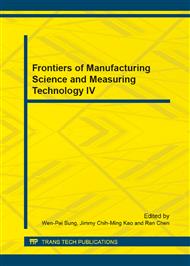[1]
I. Laptev, M. Marszalek, C. Schmid C, et al., Learning realistic human actions from movies, IEEE Conference on Computer Vision and Pattern Recognition, 2008, p.1–8.
DOI: 10.1109/cvpr.2008.4587756
Google Scholar
[2]
J. Sun, X. Wu, S. Yan, et al., Hierarchical spatio-temporal context modeling for action recognition, IEEE Conference on Computer Vision and Pattern Recognition, 2009, p.2004–(2011).
DOI: 10.1109/cvpr.2009.5206721
Google Scholar
[3]
S. Vishwanathan, Z. Sun, N. Theera-Ampornpunt N, et al., Multiple kernel learning and the SMO algorithm, Advances in Neural Information Processing Systems 23, 2010, p.2361–2369.
Google Scholar
[4]
B. Li, O. I. Camps, M. Sznaier, Cross-view activity recognition using Hankelets, IEEE Conference on Computer Vision and Pattern Recognition, 2012, p.1362–1369.
DOI: 10.1109/cvpr.2012.6247822
Google Scholar
[5]
S. Bhattacharya, R. Sukthankar, R. Jin, et al., A probabilistic representation for efficient large scale visual recognition tasks, IEEE Conference on Computer Vision and Pattern Recognition, 2011, p.2593–2600.
DOI: 10.1109/cvpr.2011.5995746
Google Scholar
[6]
A. Kovashka, K. Grauman, Learning a hierarchy of discriminative space-time neighborhood features for human action recognition, IEEE Conference on Computer Vision and Pattern Recognition, 2010, p.2046–(2053).
DOI: 10.1109/cvpr.2010.5539881
Google Scholar
[7]
J. Wang, Z. Chen, Y. Wu, Action recognition with multiscale spatio-temporal contexts, IEEE Conference on Computer Vision and Pattern Recognition, 2011, p.3185–3192.
DOI: 10.1109/cvpr.2011.5995493
Google Scholar
[8]
B. Chakraborty, M. B. Holte, T. B. Moeslund, et al., A selective spatio-temporal interest point detector for human action recognition in complex scenes, IEEE International Conference on Computer Vision, 2011, p.1776–1783.
DOI: 10.1109/iccv.2011.6126443
Google Scholar
[9]
L. Cao, Z. Liu, T. Huang, Cross-dataset action detection, IEEE Conference on Computer Vision and Pattern Recognition, 2010, p.1998–(2005).
DOI: 10.1109/cvpr.2010.5539875
Google Scholar
[10]
M. Kaâniche, F. Bremond F, Gesture recognition by learning local motion signatures, IEEE Conference on Computer Vision and Pattern Recognition, 2010, p.2745–2752.
DOI: 10.1109/cvpr.2010.5539999
Google Scholar
[11]
Z. Jiang, Z. Lin, L. S. Davis, Recognizing human actions by learning and matching shape-motion prototype trees, IEEE Transactions on Pattern Analysis and Machine Intelligence, 2012, 34(3): 533–547.
DOI: 10.1109/tpami.2011.147
Google Scholar


